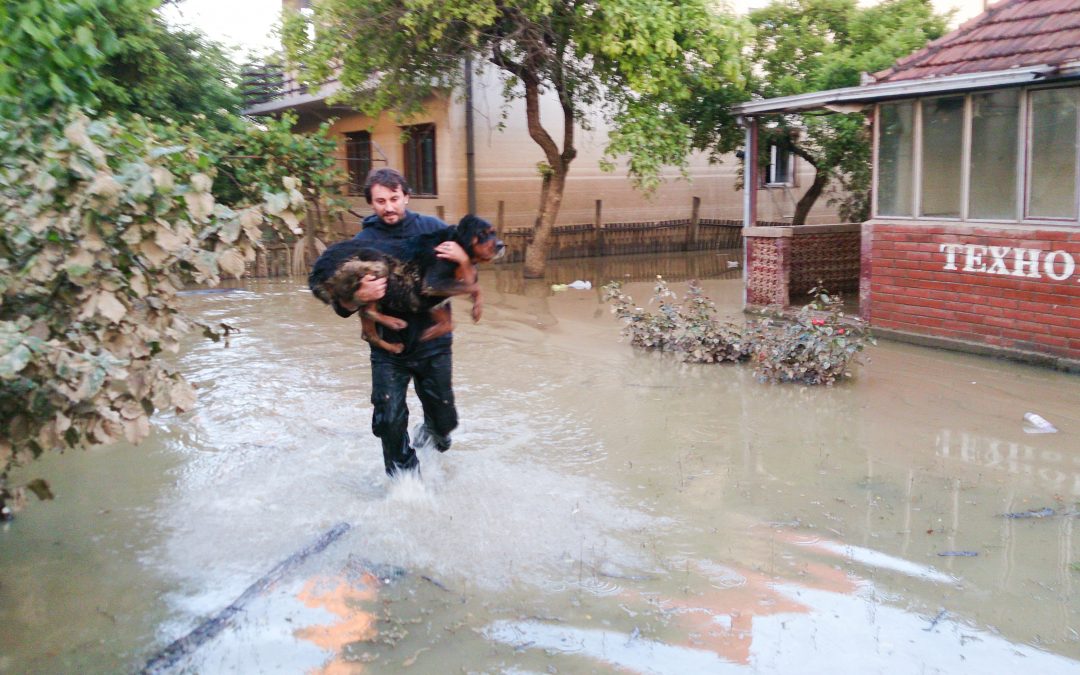There are many ways disaster can strike: Flood, Fire, Hurricane, Tornado, Hazardous Material Spill, and even Terrorist Attack. Each more prevalent in some areas of the country than others. How likely are we to have to evacuate? I can tell you from personal experience, a few years ago I had my car packed, sitting in the drive, and I was ready to leave my home – WITH MY PETS.
Our pets are like toddlers – they are entirely dependent upon us – especially in times of emergency. Tens of thousands of animals either became separated from their families, or died during Hurricane Katrina because they were not evacuated with their people. Never leave your pets behind! We have seen countless times on the news where people were evacuated and told they would be able to return to their homes in hours, and those hours turned into days! Pets were home alone, without food or water, and in terrible danger. If a situation is not safe for you – it is not safe for your pets!
Did you know most shelters – including Red Cross Shelters do not allow pets? 68% of homes in the United States have pets – and nowhere to go with them in a crisis!
We must make our own plan for evacuation with our animals.
- Do you have enough carriers for all pets in your home?
- Do your pets have ID tags with your phone number clearly readable in case you’re separated, o a pet escapes?
- Do you have a current photo of each pet (with you) for identification and proof of ownership of each of your pets?
- In case of evacuation, does each member of your family know where to meet?
- Do you have emergency supplies in your car – for you and your pet?
- Do you keep sufficient fuel in your car, and emergency cash on hand?
- Who will evacuate your pet if you are not home? Does a neighbor know to save your pets?
- What if first responders arrive at your house and you are not there. Will they know to save your pets?
Without going to extreme measures, there are some very simple things you can do…
- Put a Pet Alert Sticker on your door! List number and type of pets, your contact information, and an alternate contact – neighbor, or pet sitter.
- Keep emergency pet supplies together: Collars with tags, leashes, a ration of food, fresh water, and dishes. Be sure any medications are easily accessible.
- Have a first aid kit ready containing items for human and pet emergencies.
- Carry a card in your wallet alerting police or EMTs that you have pets at home in the event you are incapacitated. (I carry one saying I am a pet sitter and that YOUR pets may be in my care. My card lists an emergency contact so that one of my staff is alerted to take over the care of your kids)
- Know rescue breathing, CPR, and basic emergency care techniques for your pets until they can be seen by a professional. It could be the difference between life and death for your animals.
- NEVER evacuate your home and leave your pet home alone in a crate. It leaves them completely helpless.
The day we were ready to evacuate.
I don’t remember exactly how long ago this was – most likely 2010 or 2011. The ground was burning in Peshtigo. The fire was just East of Schacht Rd., between Highway 41 and Highway 64. I returned from my mid-day visits that day and stood on my deck wondering if Ansul had some sort of fire training going on. I didn’t give it a lot of thought until a neighbor told me it was a wildfire. I left my house for afternoon visits feeling confident the fire was contained. When I arrived home, my yard (and roof) was littered with ash and embers from the fire. I immediately contacted emergency services for an update on the fire. They were completely unaware that homes on my street were being affected. Shortly after, there were news crews, fire trucks, and emergency personnel trying to figure out if they could get to the fire from the back of our properties. It was then that I realized things could go very badly, very quickly. I packed food and water for my kids, grabbed portable bowls, had my dogs inside (easy to round-up), and leashes at the ready. Emergency first aid kits for people and pets were already in my car. I packed a couple of days’ worth of clothes for myself and my husband, while he was outside setting up sprinklers around our chicken coop, and releasing the chickens so they would stand a chance if the worst did come. The last things that I packed into my car were all client files, keys, and laptop so my business didn’t come to a screeching halt! One neighbor was evacuated that day because of poor health, but the rest of us were lucky. The fire was contained enough that it never reached our property lines, and we did not have to leave our homes.
While we were not prepared for such an event as far as having an actual plan, we were able to react quickly enough that our family – including our three dogs – would have been safe. A plan would have had all these evacuation items together in one place so that we would be prepared to go in 5 minutes instead of 30.
If you don’t have a plan, think about it. What would you do in an emergency? Would you be able to save your pets? Where would you go? Knowing the answer to these questions now, could pay off in a big way later! Check out the links below to help you formulate your plan!
http://www.redcross.org/prepare/disaster/pet-safety
http://www.humanesociety.org/issues/animal_rescue/tips/pets-disaster.html?credit=web_id97309811
https://www.petfinder.com/dogs/dog-care/disaster-preparedness-tips/
https://www.petfinder.com/dogs/dog-care/disaster-preparedness-pet-checklist/
https://www.petfinder.com/dogs/dog-care/disaster-preparedness-dogs/
https://www.petfinder.com/dogs/dog-care/create-disaster-plan-pets/

